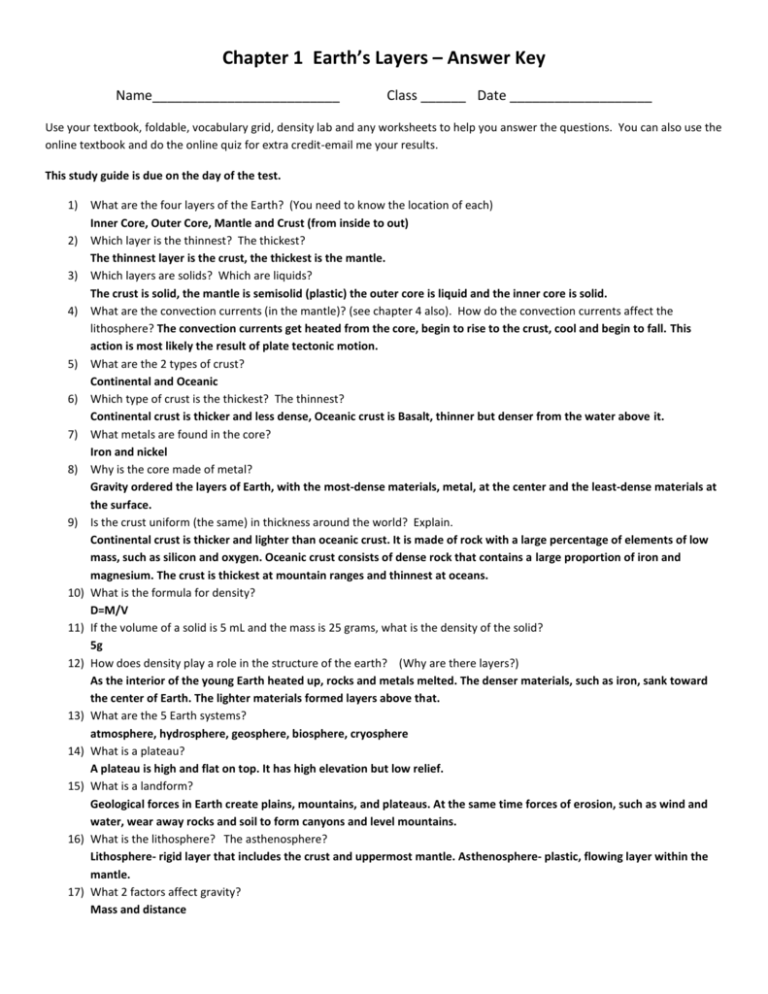Earth's Layers: Answer Key & Study Guide
advertisement

Chapter 1 Earth’s Layers – Answer Key Name_________________________ Class ______ Date ___________________ Use your textbook, foldable, vocabulary grid, density lab and any worksheets to help you answer the questions. You can also use the online textbook and do the online quiz for extra credit-email me your results. This study guide is due on the day of the test. 1) 2) 3) 4) 5) 6) 7) 8) 9) 10) 11) 12) 13) 14) 15) 16) 17) What are the four layers of the Earth? (You need to know the location of each) Inner Core, Outer Core, Mantle and Crust (from inside to out) Which layer is the thinnest? The thickest? The thinnest layer is the crust, the thickest is the mantle. Which layers are solids? Which are liquids? The crust is solid, the mantle is semisolid (plastic) the outer core is liquid and the inner core is solid. What are the convection currents (in the mantle)? (see chapter 4 also). How do the convection currents affect the lithosphere? The convection currents get heated from the core, begin to rise to the crust, cool and begin to fall. This action is most likely the result of plate tectonic motion. What are the 2 types of crust? Continental and Oceanic Which type of crust is the thickest? The thinnest? Continental crust is thicker and less dense, Oceanic crust is Basalt, thinner but denser from the water above it. What metals are found in the core? Iron and nickel Why is the core made of metal? Gravity ordered the layers of Earth, with the most-dense materials, metal, at the center and the least-dense materials at the surface. Is the crust uniform (the same) in thickness around the world? Explain. Continental crust is thicker and lighter than oceanic crust. It is made of rock with a large percentage of elements of low mass, such as silicon and oxygen. Oceanic crust consists of dense rock that contains a large proportion of iron and magnesium. The crust is thickest at mountain ranges and thinnest at oceans. What is the formula for density? D=M/V If the volume of a solid is 5 mL and the mass is 25 grams, what is the density of the solid? 5g How does density play a role in the structure of the earth? (Why are there layers?) As the interior of the young Earth heated up, rocks and metals melted. The denser materials, such as iron, sank toward the center of Earth. The lighter materials formed layers above that. What are the 5 Earth systems? atmosphere, hydrosphere, geosphere, biosphere, cryosphere What is a plateau? A plateau is high and flat on top. It has high elevation but low relief. What is a landform? Geological forces in Earth create plains, mountains, and plateaus. At the same time forces of erosion, such as wind and water, wear away rocks and soil to form canyons and level mountains. What is the lithosphere? The asthenosphere? Lithosphere- rigid layer that includes the crust and uppermost mantle. Asthenosphere- plastic, flowing layer within the mantle. What 2 factors affect gravity? Mass and distance 18) How do temperature, pressure and density change as you go deeper into the Earth? Temperature pressure and density all increase as you go from the crust towards the interior of the Earth. 19) What is the most common landform? Plains 20) Draw and label a picture showing the following layers of the Earth Asthenosphere Outer core inner core upper mantle 21) Match the layer with its description: A) B) C) D) E) F) Asthenosphere inner core lithosphere lower mantle Outer core upper mantle ___E__hot liquid iron ___C__cool solid rock ___F__hot solid rock ___A__hot melted rock ___B__very hot solid iron ___D__hottest solid rock lithosphere lower mantle




